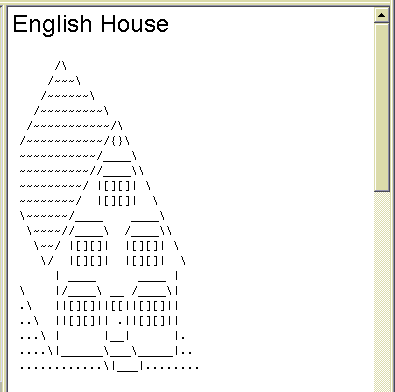
Nonverbal,
graphic elements abound, from the simple emoticon
and use of color to the hot link or pictures
and tables. Word processing and the compatibility of spreadsheet and presentation
software with word processing allow easy incorporation of tables, graphs, maps,
and pictures, as well as the addition of text boxes, lines, and color. Links
create visual transition to related material, whether the link is indicated
with text or with a symbol, picture, or portion of a map.
The imaginative use of orthographic symbols to create ASCIII graphics has transformed our view of the keyboard. The personalization of email signature lines with primitive graphics is on the wane, but ASCIII graphics may still be found defining spaces within a MOO.

The English House, ASCII art by Richard Bowman, in BC-MOO, at www.bridgewater.edu:7000
Even
the simplest presentations and Web pages
are characterized by color and texture, and they routinely include
pictures, tables, and stylized lines and bullets. Many incorporate movement: text flashes or scrolls across the
screen; animated graphics flit, vibrate, or ripple across the page.
In
addition to graphics, sound and video elements are increasingly routine.
Readers
learn to readily shift their reading patterns to process information presented
in horizontal bars, vertical lists, tables, and frames.